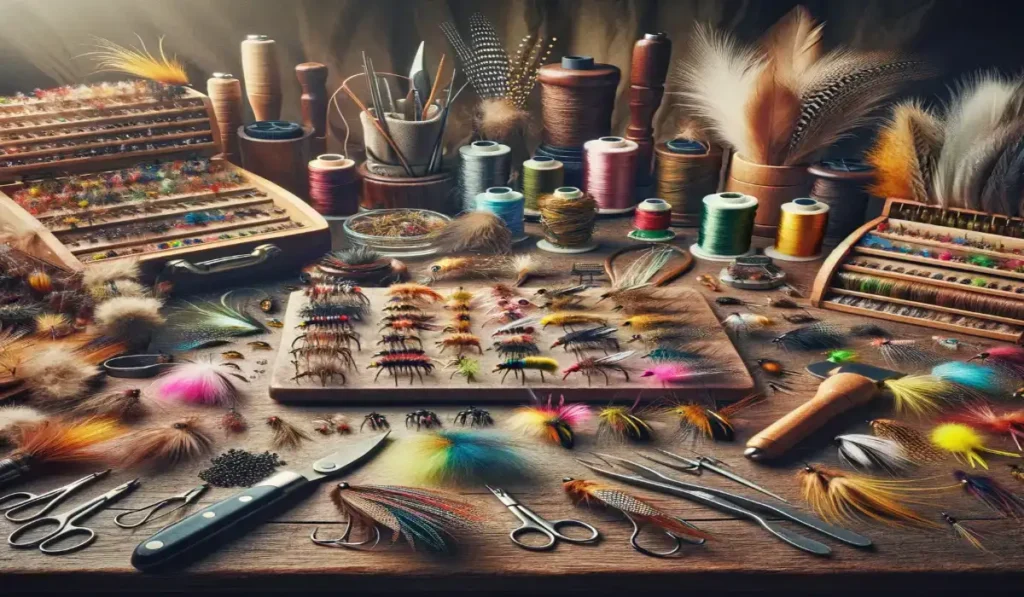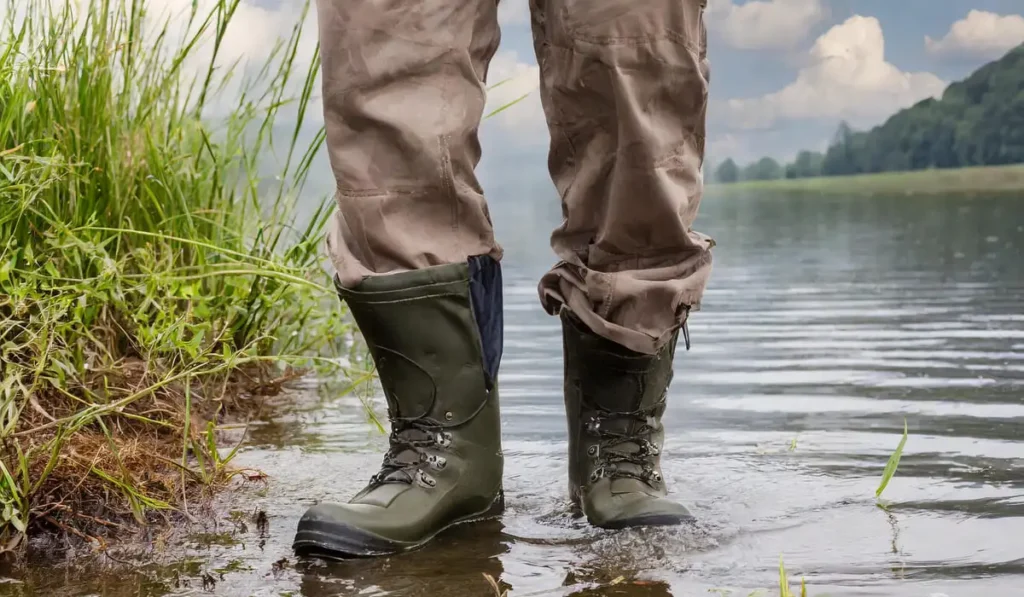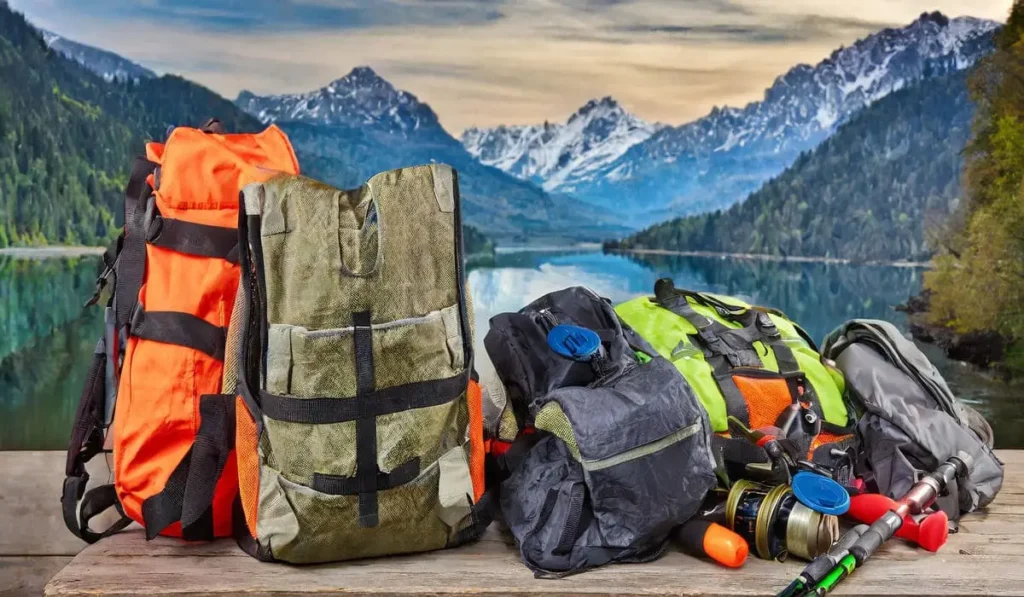Hello fishing lovers! Well, do you know about what gear do you need for fly fishing? If no, come and join us we have a lot of things to tell you to make your fishing adventure greater. Although, fishing is one of the most enjoyable adventures but on the other hand it can be scary. It is not as much easy as it seen. You need a lot of preparations and the gears are one of them. Well, choosing the right accessories for fly fishing is not an easy task but we have tried to make it easy for you.
Fly-fishing does not all about rod, reel, and line. There are many other accessories you will need. It’s very important to equip yourself with the right tools before leaving. From protective gear like waders and boots , vests and packs, polarized sunglasses to handy instruments like strike indicators are the things you will need. These all-essential things play an important role to enhance your comfort, safety, and effectiveness while fly fishing.
In this guide, we’ll dive into the world of essential accessories for successful fly fishing. This comprehensive guide is all about key gear categories, their importance, and providing tips how to choose the right gears for your fishing. These tools selection is also beads on your preferences, style of fishing and type of fly fishing.
Whether you’re a pro fly fisherman looking to upgrade your gear or a beginner seeking guidance about the piece of equipment, this article is for both of you. So, choose your gear and let’s explore the world of fly fishing and its accessories for the great journey.
- 1. Understanding the Importance of Fly Rods
- 2. Choosing the Right Fly Fishing Reel
- 2. Type of Material Used in Fishing Reel:
- 3. Exploring Different Types of Fly Lines
- 4. Essential Flies and Fly Tying Materials
- 5. The Significance of Leaders and Tippets in Fly Fishing
- 6. Waders and Wading Boots are Essential Fly Fishing Gears:
- 7. Fly Fishing Vests and Packs are Prime Fly Fishing Accessories
- 8. Other Essential Accessories need to Get Started Fly Fishing
- Summary
1. Understanding the Importance of Fly Rods
Fly fishing rod is the most important tool in fly fishing adventure for casting line control, and overall angling process. A flexible and responsive fly rod is needed for delivering flies to their target.
Fly rods are available in various designs. Each has different construction and performance factors like length, weight, action, and material. Here action, refers to how the rod flexes and rebounds while casting in the water and how it acts in different fishing conditions.
Fly rods are categorized into Slow-action rods, medium action rods and fast action rods. Slow action rods provide forgiveness and delicacy and is perfect for subtle presentations in tight casting quarters. Medium-action rods is for balancing power and precision by making them versatile across various fishing scenarios. Fast-action rods are stiffer and more powerful and appropriate in casting distance and accuracy. It is ideal for windy conditions or catching larger fish species.
Besides action other factors like rod length and weight also effect on the performance. For example, longer rods provide distant with a good control while shorter rods provide casting in confined spaces with accuracy.
Similarly, weight of the rods also affects the fly casting ability, lighter rods are suitable for catching smaller fish and heavier rods for larger species. So, select the rods according to your need, environmental conditions and fishing conditions. It increases the chances of success.
2. Choosing the Right Fly Fishing Reel
Fly reel is another important tool of any fly-fishing setup. It serves as the most important link between the fly angler and the fish. It gives control, balance, and storage for the fly fishing line by effecting the overall performance and success on the water. Variety of fishing-reels are available but when it comes to select a fly reel make sure it meets your specific fishing needs.
First and most important thing is to consider the size of the fly-reel and weight of the fly rod since both rod and reel works together. Match the reel size to the rod weight since it ensures proper balance and casting performance with smooth and good control. Larger reels are designed for heavier rods and lines, while smaller are designed for lighter setups.
Another thing you have to focus while purchasing is the type of drag system in the fly-reel. There are two main types of drag system:
I. Click-and-Pawl
Click-and-pawl systems are simple, light weighted and reliable It is specially designed for smaller fish species and lighter fishing scenarios. It produces a clicking sound as the line is released.
II. Disc Drag
On the other hand, disc drag systems comes with more precise and adjustable drag settings which makes them ideal for larger fish species and challenging fishing conditions.
2. Type of Material Used in Fishing Reel:
The next thing you have to see is material construction when choosing a fly reel. Reels are made up of various materials such as aluminum, graphite, and composite materials. Aluminum reels are known for their durability and corrosion resistance and is suitable for saltwater fishing. On the contrary Graphite, and composite reels are lighter in weight and more budget friendly which makes them popular choices for freshwater enthusiasts.
Additionally, there are also some other features and accessories that effect on your fishing experience. These include large arbor spools which are for quick line retrieval, interchangeable spools that allows versatile fishing setups. Sealed drag systems which provide protection against water and debris, ensuring smooth activity in harsh or challenging conditions.
While selecting fly reels all these basic features should be kept in mind. Select according to your fishing needs, environmental conditions and preferences and you will be ready to explore your fishing experience and increase your chances of success on the water.
3. Exploring Different Types of Fly Lines
In fly fishing, the fly line also serves as the essential connection between the angler and the fly. It plays a vital role in casting accuracy, presentation, and overall fishing success. Variety of options of fly lines are available. First you have to understand the various types of fly-lines and their unique characteristics for selecting the right-fly line for your fishing needs.
I. Weight-Forward (WF)
Weight-forward lines is widely used type of line and is the most versatile type. It consists of a thicker and heavier section at the front, these lines efficiently load the rod for longer casts and accuracy. They are ideal for enthusiasts who are beginner since it is suitable for a wide range of fishing conditions and casting styles.
II. Double Taper (DT)
Double taper lines have a same diameter throughout, with gradual tapers at both the ends of fly lines. It provides precise control and delicate presentations; they are excellent in dry fly fishing and small stream angling. Additionally, they are reversible which allows anglers to flip the line for extended use.
III. Shooting Taper (ST)
It is designed for maximum distance casting and it helps in long casts with ease. It is commonly used in saltwater and large river environments; they facilitate long casts with ease.
IV. Sink-Tip
Sink-tip lines comes with a sinking section at the tip, which allows flies to reach deeper water where fish may be holding. It is perfect for fishing streamers and nymphs in rivers, lakes, and saltwater. They provide versatility in targeting subsurface species.
V. Intermediate
These lines come with slow-sinking rate and they remain just below the surface of the water. It is ideal for fishing in shallow water.
VI. Floating
It is designed to float on the surface, floating lines are versatile options and is suitable for a wide range of fishing purposes. It is effective for fishing dry flies and surface patterns in freshwater environments and offer excellent visibility.
VII. Sinking
Sinking fly lines are available in various sinking rates, sinking lines enables anglers to fish at different depths of water to target species. They are good at reaching fish, holding in deep pools, lakes, and saltwater environments.
So, these were the types of fly-lines each with its own unique characteristics. By exploring all types and its characteristics you will be able to select the line according to your need whether you’re casting in shallow water or deep water. Moreover, you can read guides on how to improve the lifespan of fly fishing line to make it long last.
4. Essential Flies and Fly Tying Materials
Flies can be said it is the heart and soul of fly fishing. It acts as artificial copy of natural insects, baitfish, or aquatic species. For fly fishers it is important to select flies and fly-tying materials to target the fishes in diverse fishing conditions. Let’s discuss some must-have flies and materials for fly-tying.

I. Dry Flies
These flies just look like insects that float on the water’s surface, like mayflies, caddisflies, and stoneflies. Basic dry flies include the Adams, Elk Hair Caddis, Royal Wulff, and Parachute Adams. It is perfect for trout fishing in rivers and streams.
II. Nymphs
These are designed for fishing beneath the surface of water. It is perfect for freshwater species like trout and steelhead.
III. Streamer
Streamer-flies are larger flies that looks similar to baitfish or leeches and attracts fish like trout, bass and pike.
Fly Fishing Equipment need in Fly Tying
Tying is also very important task in this journey. It is very important to tie the fly in the right manner that it looks similar to original fly. There are different types of materials like feathers, fur, hooks, dubbing, thread, and synthetic materials are used to make tying stuff.
Tools like scissors, hackle pliers, whip finishers, bobbin holders, and dubbing twisters are necessary for efficient fly tying. These tools make you to tie flies with precision and finesse and you will definitely get professional-quality results.
Various types of fly-tying materials are available you can choose according to the changing conditions and maximize their success on the water. Whether you are experiencing trout in mountain streams or casting for bass in lakes, having the right flies and materials will be game changer for your adventure.
5. The Significance of Leaders and Tippets in Fly Fishing
When we talk about what piece of gear you need for fly fishing, Leaders and tippets are important gears of any fly fishing setup. It is connection between the fly line and the fly itself. To understanding their roles and significance in fly fishing is much important for you to enhance fishing success. So, stay with us to know more about leaders and tippets.
I. Leaders:
The leaders play a major role in fly fishing. These tapered sections of monofilament or fluorocarbon line serve several critical functions in fly fishing. It provides a connection between the thick, weight-forward fly line and the delicate fly which provides energy during casting in the water. These Leaders are available in various lengths and tapers, shorter leaders are suitable for small streams and creeks, while longer leaders are for larger rivers and lakes. The taper of the leader effects the turnover and presentation. Longer tapers offers smoother turnover and more delicate presentations, while the shorter, stiffer tapers provide power and accuracy, especially in windy conditions.
II. Tippet:
This gear of fly fishing serves as the terminal section of the leader where the fly is attached, tippets are thinner and lighter than the leader. They make seamless transition between the leader and the fly which enables the natural presentation in the water. Tippets comes in different sizes, ranging from 0X (the thickest) to 8X (the thinnest). There are commonly three types of tippet material that is used in fly fishing, monofilament, fluorocarbon and copolymer.
6. Waders and Wading Boots are Essential Fly Fishing Gears:
Waders and wading-boots both are the important gears you need in fly fishing. Waders are the pants used in fly fishing while casting. It keeps you dry in the water. While boots is the accessory which cannot be neglected. It protects your feet in every type of challenging fishing situations. It plays a significant role as it provides stability, protection against rough areas, harsh materials, debris and water. It has various types according to your preference and environmental and water conditions. A good pair of waders boot enhance your ability in the water during casting.

I. Waders:
As we know that wader are the pants used in the fly-fishing process. These are waterproof pants and they are designed to keep anglers dry while wading. They come in various types and styles, including chest, waist-high, and hip waders which offers the angler a good coverage and protection. As chest waders provide full-body coverage hence they are ideal for fishing in deeper or colder waters. On the other hand, Waist-high waders provides coverage up to the waist which is suitable for shallower streams or warmer weather. Another type Hip waders, covering up to the hips, are perfect for shallow waters or quick outings.
When it comes to choose see its properties including material, breathability, and insulation. Neoprene waders provides you excellent insulation when you’re fishing in cold for cold, on the contrary breathable fabric waders provide comfort in warm conditions. It’s better to look for reinforced knees and seat areas for durability.
II. Wading Boots:
Wading pair of boots are specially designed for the anglers which provide traction and stability on wet surfaces. They also come in various styles, like felt sole, rubber sole, and studded sole boots. Felt sole boots gives angler exceptional grip on slippery rocks, and is suitable for fast-flowing streams. Whereas rubber sole boots are known to be its durability and versatility and is suitable for various conditions. Studded sole pair of boots consists of metal studs which is for added traction on slick surfaces.
Look for the properties when choosing wading-boots like fit, support, and ankle protection. It should bet comfortable fit to prevent blisters. Prefer a pair which provides ankle support and stability to reduce the risk of injuries. Besides these a pair with Gravel guards can prevent debris from entering boots.
Investing in high-quality waders and wading pair of boots will never disappoint you. Choose a pair that fit well and suit your fishing needs by providing safety, and comfortable mobility while wading. No matter whether you are targeting trout in a mountain stream or bonefish in a saltwater, the right gear enhances your efficiency and make your fishing more enjoyable.
7. Fly Fishing Vests and Packs are Prime Fly Fishing Accessories
Fly fishing-vests and packs are categorized among the important accessories that an enthusiast needs while casting. They play an important role by keeping you safe as they are waterproof. Let’s discuss more about the role and importance of fly fishing-vests and packs in organizing your gear and how to select the right-vests and packs according to your needs.

I. Fly Fishing Vests:
This is one of the useful equipment. Besides providing you protection there are other properties which makes it attractive for fly fisher to buy these vests. These vests consist of pockets, compartments, and attachment points for storing fly boxes, leaders, tippets, tools, and other things. There are various types and style of vests, including traditional, sling, and hybrid-vests, each contains different storage preferences and mobility requirements.
These vests also provide symmetrical layout with pockets on the front and back. These pockets have storage space for gear and accessories. Sling-vests have a single shoulder strap and a rotating design which enables anglers to swing the pack around for easy gear access without removing it. The other type is Hybrid-vests which is the combination of traditional and sling designs. It provides versatility and customization options for anglers with specific storage needs.
When it comes to select prefer pocket layout, material, and fit. A vest with multiple pockets will be the best choice to carry gears separately. Always choose lightweight, breathable materials for comfort.
II. Fly Fishing packs:
This is an alternative for storage of gear. They are light weighted and available in various styles, including chest, waist, sling, and backpacks. They consist of different storage capacities and convenience levels.
Chest packs are compact pack that attach to the front of the angler, which provides easy access to gear without hindering movement. Whereas, waist packs provide additional storage around the waist. On the other hand, sling packs consists of a single shoulder strap for quick gear access. Hence, backpacks should be used as they provide maximum storage capacity for gear, clothing, food, and other accessories.
So, we can conclude that while purchasing the packs consider storage capacity, comfort, and versatility. Always look for packs that consists of multiple compartments, pockets, and attachment points to keep gear organized. Moreover, prefer durable, water-resistant materials to protect against the elements and off course choose a comfortable and secure fit to avoid any mismanagement during fishing trips.
When you invest in a high-quality fly fishing-vest or pack according to your storage needs it enhances good organization and easy accessibility while fishing. No matter you prefer the classic design of a vest or the versatility of a pack, having a well-organized and having good storage compartments is the only solution and is the key to a successful and enjoyable fishing adventure.
8. Other Essential Accessories need to Get Started Fly Fishing
I. Fly Boxes
Fly boxes are used to organize and carry fly collection. They are available in various sizes and materials, including waterproof plastic and aluminum. It’s better to choose boxes with clear lids for easy fly identification and to make your work easier.
II. Nippers and Forceps
Nippers and forceps are the tools used for cutting line, trimming knots, and removing hooks. As they are used for cutting and trimming look for sharp, stainless-steel blades with comfortable handles.
III. Fly Floatant and Sinkant
Fly Floating and sinkant treats dry flies and nymphs to improve sink rate. It will be good to choose environmental-friendly formulas. You can reapply as needed.
IV. Leader Straighteners and Cleaners
These gears maintain leaders and tippets for smooth, tangle-free casting. You can use straighteners to remove memory and cleaners to remove dirt and debris.
V. Hook Sharpeners
They are used to maintain sharp hooks for optimal hook sets. Always choose sharpeners with fine-grit surfaces for precise sharpening.
VI. Line Management Accessories:
These accessories keep fly lines in top condition with cleaners, dressings, and degreasers. It is helpful to Improve casting distance and accuracy.
VII. Polarized Sunglasses:
Pair of polarized sunglasses will protect your eyes and make your work smooth. It is essential for improved visibility and safety. It’s better to look for lenses treated with a polarizing filter to reduce glare and enhance contrast.
VIII. Strike Indicator:
There are various types of strike-indicator that are used in fly fishing like balloon, yarn, foam etc. The basic task of these indicator is to tell angler about the fly that it is still there or taken by the fish that increase the angler chances of success.
When you finished by getting all these stuff, then you have to safely carry all this stuff to your fly fishing spot.
Summary
We are sure you will not worry anymore when it comes what gear you need for fly fishing. We have discussed all the essential tools you need for the adventure. Its not all about the equipment but it’s all about having the right equipment. There are various types of tools are available but you should know your preferences, needs and environmental conditions then you will be able to buy right tools. From waders and wading boots to vests, packs, polarized sunglasses, and strike-indicators, all these equipment play a major role in enhancing your comfort, safety, and effectiveness on the water while casting.
Firstly, you should know what gear do you need for fly fishing. Secondly, when you are ready to buy then always invest in high quality accessories and definitely according to your needs too. It will maximize the chances of success. So, we hope this article will be very helpful for the anglers who loves to explore fly fishing adventure. This article covered each and every tool you need. Now, it’s your turn to choose your best equipment and enjoy the happy fishing.


